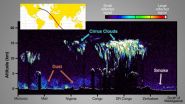(Press-News.org) San Diego, CA--Exposure to low doses of hormone-disrupting chemicals early in life can alter gene expression in the liver as well as liver function, increasing the susceptibility to obesity and other metabolic diseases in adulthood, a new study finds. Results of the animal study will be presented Friday at the Endocrine Society's 97th annual meeting in San Diego.
Brief exposure in infancy to several industrial chemicals that are common in the human environment, particularly bisphenol A (BPA), caused fatty liver disease in adulthood, the researchers found in rats.
"Even a short exposure to these endocrine disruptors at the wrong time of development has a lifelong effect on the individual," said the study's senior investigator, Cheryl Lyn Walker, PhD, director of the Texas A&M University Health Science Center Institute of Biosciences and Technology, Houston.
Because the changes occur at the molecular level, they are not evident until later in life, she said.
Scientists have suspected that exposure early in life to BPA and certain other chemicals that disrupt the action of hormones, called endocrine disruptors, may promote obesity in adulthood, but the exact cause is unknown. In research funded by the National Institute of Environmental Health Sciences, Walker and her colleagues focused on the liver, which plays a central role in fat metabolism and obesity.
The researchers gave groups of newborn rats low doses of one of four different endocrine disruptors during a critical period of liver development: the three days immediately after birth. They then examined liver tissue from these chemically exposed animals either immediately after exposure or 70 days later, when the rats were adults. They compared liver samples to those obtained from nonexposed control rats.
BPA and another endocrine disruptor, tributyltin--an additive in paint and textiles--caused liver damage consistent with human nonalcoholic hepatic steatosis, or fatty liver, the investigators reported.
Analysis of liver gene expression patterns of the exposed rats found that the endocrine disruptors induced developmental reprogramming of the animals' epigenomes. In both rodents and humans, the epigenome programs the genome, our complete set of DNA.
Walker said they suspect that "these chemical exposures interfere with the epigenetic 'programmers' to do their job. It's like a glitch on your computer that causes a software program to get installed incorrectly."
This reprogramming of the liver could potentially drive obesity, she explained. Unlike genetic defects, however, epigenetic programming can be reversed.
"It may be possible to reset the malprogramming, or 'malware', to reduce the risk of obesity and associated diseases," Walker said.
With additional research and knowledge, she said, it may also be possible one day to use these epigenetic changes as markers, which can tell that a child is at risk of obesity and other diseases.
INFORMATION:
Founded in 1916, the Endocrine Society is the world's oldest, largest and most active organization devoted to research on hormones and the clinical practice of endocrinology. Today, the Endocrine Society's membership consists of over 18,000 scientists, physicians, educators, nurses and students in 122 countries. Society members represent all basic, applied and clinical interests in endocrinology. The Endocrine Society is based in Washington, DC. To learn more about the Society and the field of endocrinology, visit our site at http://www.endocrine.org. Follow us on Twitter at https://twitter.com/#!/EndoMedia.
San Diego, CA--In patients with chronic heart failure, the vitamin D metabolite 1,25-dihydroxyvitamin D (1,25(OH)2D), also called calcitriol, and its ratio to parathyroid hormone (PTH 1-84) may help predict cardiovascular death; and patients with decreased calcitriol and decreased ratio of calcitriol to PTH might benefit from more aggressive supplementation, a new study finds. The results will be presented Friday, March 6, at ENDO 2015, the annual meeting of the Endocrine Society in San Diego.
Heart failure, with high morbidity and mortality, is increasingly prevalent ...
San Diego, CA--A treatment known as mindfulness-based stress reduction (MBSR) may decrease fasting glucose and improve quality of life in overweight and obese women, new research suggests. The results will be presented in a poster Friday, March 6, at ENDO 2015, the annual meeting of the Endocrine Society in San Diego.
MBSR is a secular mindfulness meditation program that was developed by Jon Kabat-Zinn, PhD at the University of Massachusetts Medical School. The practice of MBSR involves paying attention to one's thoughts, feelings, and bodily sensations in the present ...
San Diego, CA--A mother's age at childbirth may affect her male baby's birth weight as well as his adult glucose metabolism, new research shows. The results will be presented Friday, March 6, at ENDO 2015, the annual meeting of the Endocrine Society in San Diego.
"Our findings indicate that women giving birth at a very young (under 25 years) or older (over 34 years) age might result in less favorable sugar handling and thus possibly higher risk for developing type 2 diabetes in their sons," said Charlotte Verroken, MD, of the Department of Endocrinology of Ghent University ...
(MEMPHIS, Tenn. - March 6, 2015) The St. Jude Children's Research Hospital--Washington University Pediatric Cancer Genome Project reports that a highly aggressive form of leukemia in infants has surprisingly few mutations beyond the chromosomal rearrangement that affects the MLL gene. The findings suggest that targeting the alteration is likely the key to improved survival. The research appeared online ahead of print this week in the scientific journal Nature Genetics.
The study is the most comprehensive analysis yet of this rare but aggressive subtype of pediatric acute ...
Alexandria, VA-- Children born during, and up to three years after, the devastating 1997-1998 El Niño event in northern Peru were found to be shorter than their peers in a new study covered in EARTH Magazine. The rising waters wiped out crops, drowned livestock, cut off bridges, and caused prolonged famine in many rural villages. Now, a new study that tracked long-term health impacts on children from the affected region has found that a decade later, the children continue to bear signs of the hardship endured early in their lives.
Learn how the children's health ...
(Boston)--In a review article recently published in the journal Clinical and Translational Medicine, researchers from Boston University School of Medicine (BUSM) shed new light on the underlying processes of tumor metastasis and highlight the role of epigenetics in this process. By comparing embryogenesis with cancer metastasis they hypothesize that reversible epigenetic events regulate the development of different types of metastatic cancers. They also describe that the surrounding cells of the tumors (stromal cells) play a significant role in this process.
The BUSM ...
From Saharan dust storms to icy clouds to smoke on the opposite side of the continent, the first image from NASA's newest cloud- and aerosol-measuring instrument provides a profile of the atmosphere above Africa.
The Cloud-Aerosol Transport System instrument (CATS), was launched Jan. 10 aboard a SpaceX Dragon spacecraft, and was installed on the International Space Station on Jan. 22. From its berth on the station, CATS sends laser pulses toward Earth, detecting the photons that bounce off of particles in the atmosphere to measure clouds, volcanic ash, pollutants, dust ...
If you walk into your local drug store and ask for a supplement to help you sleep, you might be directed to a bottle labeled "melatonin." The hormone supplement's use as a sleep aid is supported by anecdotal evidence and even some reputable research studies. However, our bodies also make melatonin naturally, and until a recent Caltech study using zebrafish, no one knew how--or even if--this melatonin contributed to our natural sleep. The new work suggests that even in the absence of a supplement, naturally occurring melatonin may help us fall and stay asleep.
The study ...
(Boston)--Racial and ethnic disparities in the receipt of health care (typically referring to minorities not receiving needed care) are well known. A recent review in the journal Milbank Memorial Quarterly has now found that while race/ethnicity is not consistently associated with the overuse of medical care (unnecessary care that does not improve patient outcomes). However, when overuse occurs, a substantial proportion occurs among white patients. These findings may lead to a better understanding of how and why race/ethnicity might be associated with overuse and may result ...
(WASHINGTON, March, 6, 2015) - A report, released today from the American Society of Hematology (ASH) in its journal, Blood, presents an innovative, sustainable new role for hematologists, particularly those specializing in non-malignant blood diseases, for today's rapidly changing U.S. health-care system. The report, published online as a Blood Forum article, outlines several models for a "systems-based clinical hematologist," a centralized position within hospitals and health-care systems specializing in non-malignant blood disorders.
In the report, "The Role of Hematologists ...

